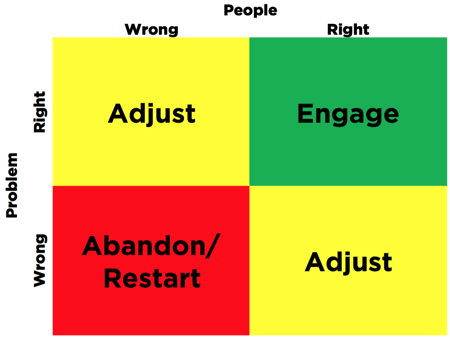 One of the primary jobs of anyone serving the role of a sales manager is to coach their salespeople and ensure that they’re taking the best course of action to efficiently and effectively close new business.
One of the primary jobs of anyone serving the role of a sales manager is to coach their salespeople and ensure that they’re taking the best course of action to efficiently and effectively close new business.
Balancing the optimism of salespeople with the discipline to ensure they’re neither pursuing the wrong opportunities or moving too fast through the sales process is one of the biggest challenges facing managers. While I certainly believe in the philosophy you miss 100% of the shots you don’t take, taking the proverbial shot too early is equally as bad and often worse.
Over the years, I’ve developed a simple grid that can be used to quickly assess any opportunity. It comes from assessing two points:
- Are we talking with the right people?
- Are we talking about the right problems?
 Determining where an opportunity is in the grid provides the guidance you need about proceeding to a proposal.
Determining where an opportunity is in the grid provides the guidance you need about proceeding to a proposal.
I’ve developed five questions that I use throughout the sales process to coach salespeople in effective sales strategies, guide them to stand out with prospects by digging deeper than their competitors do, and to develop the discipline in managing sales opportunities that is crucial for success today.
You’ll see that these five question track right along the path of an effective sales strategy. If a salesperson does not have a clear answer to the first question, they can’t have one to the second and so on. They also align to (and are in order of) the most common sales mistakes that I see made by salespeople. These five questions will create the discipline needed to shorten the sales cycle by slowing the sales process down.
Are we talking to the right people?
Early in my sales career I learned the crucial distinction between the point of receptivity and the point of opportunity. The point of receptivity provides the easiest entry point to begin a sales conversation. It’s easy to confuse receptivity with authority. Just because someone is interested or even excited about what’s being offered, doesn’t mean they can do anything to make a change.
It’s for this reason that you must be asking if you’re talking with the right people. Figuring out who those people are is an important part of developing buyer personas.
What is the specific problem(s) we are solving?
Too often salespeople are so focused on the solutions that they’re offering that they forget to clearly identify the problem that they’re solving. Additionally, because salespeople have far more familiarity with the issues, they’ll often see the problem before the prospect does. It’s important that the problem be mutually identified before you can effectively proceed.
When asking salespeople this question be certain that they’re providing specific answers. For example, “we’re going to help grow top line revenue,” or “they need to cut costs” is not a sufficient answer. In both cases those statements are far too vague (and the first is really an expression of a solution).
You’re looking for an answer that would sound something closer to, “They’ve identified that there are inefficiencies in the supply chain process that they believe are causing their costs to be higher then they should be. They currently are in the midst of an efficiency initiative where they are looking to identify cost reduction opportunities while also identifying different approaches to address them.”
If the problem has not been fully fleshed out and identified, you’re still in the early stages of your sales process (whatever stage you may call that) and you should treat the situation as such.
What are the consequences the prospect has shared if the problem(s) is not solved?
Just because someone has a problem does not mean they are going to do anything about it. Additionally, the effort and investment they’ll ultimately make in addressing a problem is directly related to the size and costs they perceive the problem to be costing them.
Salespeople often jump right into solution/presentation mode once they hear the prospect acknowledge there’s a problem they can solve. This leads to steps being skipped and multiplies the probability that your proposal ends in what I like to call sales purgatory – that place where prospects don’t say no to you, but they don’t say yes either.
When getting answers from your salespeople, here again, you’re looking for specifics. Taking the example from the first question, you’re looking for answers that resemble, “Our initial analysis with them indicates that they could eliminate 3 – 5% of direct costs, while having an even bigger impact on some of their other processes. We estimate the total cost of not addressing the problem to be somewhere between $1.6 and $2.8 million.”
If you can’t clearly identify the cost of the problem (COP) you can’t have confidence in what the prospect will be willing to do to solve it. In today’s buying processes it opens a Donald Trump-huge-sized vulnerability in your sales efforts. As the process moves closer to the decision, your solution begins to compete with every other offer your prospect is considering from those that relate to the problem you are addressing and to those that don’t. If the COP isn’t clear, you can lose the business to a competitor providing services to a completely different part of the prospect’s organization.
What alternatives does the prospect have to solve the problem(s)?
There are always alternatives. No matter how good or unique you think you are, there are a multitude of ways a prospect can address the problems you’ve identified including the option of doing nothing.
When salespeople haven’t considered and discussed those options with their prospects, there are almost always surprises that slow down and limit the profitability of a sale at best, and cause you to lose the whole thing at worst.
A unique role that your salespeople play is that they represent the selling organization when talking with the prospect, but they represent the prospect when discussing strategies with the selling organization. If the salesperson can’t articulate the options and alternatives clearly, they are demonstrating two problems:
- First they are demonstrating that they clearly don’t understand their prospect deeply enough, so you’ve got to ask the question if they don’t understand this, what else are they missing?
- Second, you can’t assess your strengths and vulnerabilities, so you’ll ultimately be putting together your proposal in the dark.
Why is our approach the best choice?
The last question should be the simplest, yet I regularly see salespeople struggle with answering it to the point they lose the sale they should have won. It’s kind of like running for President without a clear, concise and powerful answer to the question, “Why should you be President?”
I regularly see companies spend significant money in developing powerful messaging for the initial stage of the sales process that totally ignores the end. They practice, drill and rehearse their elevator speech yet never stop to clearly answer this question before making their proposal.
If you’ve been able to clearly answer the first four questions I’ve listed here, answering this question shouldn’t be difficult. Alternatively, if you’ve missed any of the answers, it’s virtually impossible to answer this question effectively.
When working on your answer to this question you must be concise, genuine, clear and impactful.
Start asking your salespeople these questions, and don’t stop until they come to you answering the questions automatically (and actually don’t even stop asking these questions then). Doing so will ensure that your salespeople aren’t skipping steps, you’ll identify and eliminate barriers before they cost you the sale, and they’ll create the predictability and effectiveness in the sales process that you’re looking for.

 Doug Davidoff
Doug Davidoff